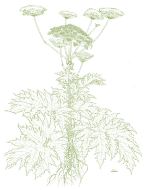Caution: Poisonous Plants
By Rebecca Willison
 Stands of Giant hogweed, Heracleum mantegazzianum, have been identified in several areas throughout Muskoka, most notably in disturbed roadside areas within the Townships of Muskoka Lakes and Georgian Bay.
Stands of Giant hogweed, Heracleum mantegazzianum, have been identified in several areas throughout Muskoka, most notably in disturbed roadside areas within the Townships of Muskoka Lakes and Georgian Bay.
Due to the danger to public health that this plant poses, some municipalities have developed programs to remove Giant hogweed on public property. But what can you, as a landowner, do if you find this plant on your private property?
Giant hogweed is a perennial member of the Carrot Family native to Asia. Like many invasive plant species, Giant hogweed was brought into Canada as a garden curiosity, but because of its tenacious and invasive nature, it quickly becomes a pest within ornamental gardens and readily escapes. Giant hogweed has the potential to spread readily and grows along roadsides, ditches and streams.
In addition to ecological impacts such as crowding out desirable native vegetation with its aggressive growth, Giant hogweed poses a serious public health hazard. The plant exudes a clear watery sap that, upon contact with human and animal skin, sensitizes the skin to the ultraviolet light in sunlight, causing photodermatitis.
This photodermatitis can cause severe burns to the affected areas, resulting in severe blistering and painful dermatitis. These blisters can develop into purplish or blackened scars. Contact with the eyes can cause temporary and sometimes permanent blindness.
What You Can Do
Wherever possible, plants should be removed manually. Before coming into contact with the plant, equip yourself with goggles, rubber gloves, rubber boots and Tyvek coveralls. If your skin comes in contact with Giant hogweed, wash with soap and water immediately, avoid direct exposure to sunlight and seek medical advice.
The most appropriate time to remove plants is in late April or early May as plants are typically less than 30 cm in height and are easier to dig up. Using a shovel, dig up as much of the taproot as possible and leave the dug up plant material on the ground to degrade (unless there is the risk of children or pets coming into contact with it).
Cover the treated area with a landscape fabric, and then cover the landscape fabric with a bark mulch. The use of landscape fabric and mulch is necessary to inhibit the germination of non-desirable weedy plants.
Once the plant has been removed, thoroughly wash your rubber boots and gloves using soap, water and a scrub brush before removing your protective clothing.
Evaluate the affected area in early June and remove any regrowth. Then visit the area one last time before July 1st to remove any regrowth and stray plants.
Tips for Prevention
- Prevent giant hogweed from establishing in the first place by monitoring unmaintained open space areas and vacant lots, especially near water.
- In areas where the plant has been eradicated or removed, cover with a competitive mulch or some type of physical barrier in order to prevent the emergence of either new seedling Giant hogweed plants or other undesirable vegetation.
- Plant native vegetation suited to the site to prevent a reinfestation.
- Carefully examine plants sold as cow parsnip. Giant hogweed is sometimes misidentified and sold by nurseries and at local plant sales.
Identification
- HEIGHT: Height: 1 to 5.5 metres.
- LEAVES: Large, deeply cut with sharp coarse teeth, reaching widths in excess of 1 metre.
- STEMS: Covered in coarse, whisker-like hairs with red/purple spots.
- FLOWERS: White, umbrella shaped, up to 1.2 metres across.
- SIMILAR SPECIES: Cow parsnip and Angelica. Giant hogweed is distinguished by its larger size and purple spots on the stem.
Past articles are available in this blog under the Watershed Notes Articles category or under Past Articles in the Resources section.
